17 17 Systems Analysis: Patient Management System Requirements
VerifiedAdded on 2020/10/22
|21
|2216
|435
Report
AI Summary
This report presents a comprehensive systems analysis of a patient management system, addressing key aspects such as stakeholder identification, including government, public, physicians, nurses, pharmacists, and business managers, and their respective needs and goals. The analysis employs a stakeholder quadrant to categorize these groups. The report details information collection methods, including interviews and questionnaires, outlining specific questions to gather relevant data. It then delineates functional and non-functional requirements, emphasizing the system's services and constraints. Use case modeling is employed to describe the system's functionalities, including booking appointments, providing problem details, assigning doctors, prescribing medication, generating reports and bills, and making payments. The report includes domain modeling, class diagrams, state machine diagrams, activity diagrams, system sequence diagrams, and CRUD analysis to illustrate the system's data entities and processes. References to supporting literature are also provided.
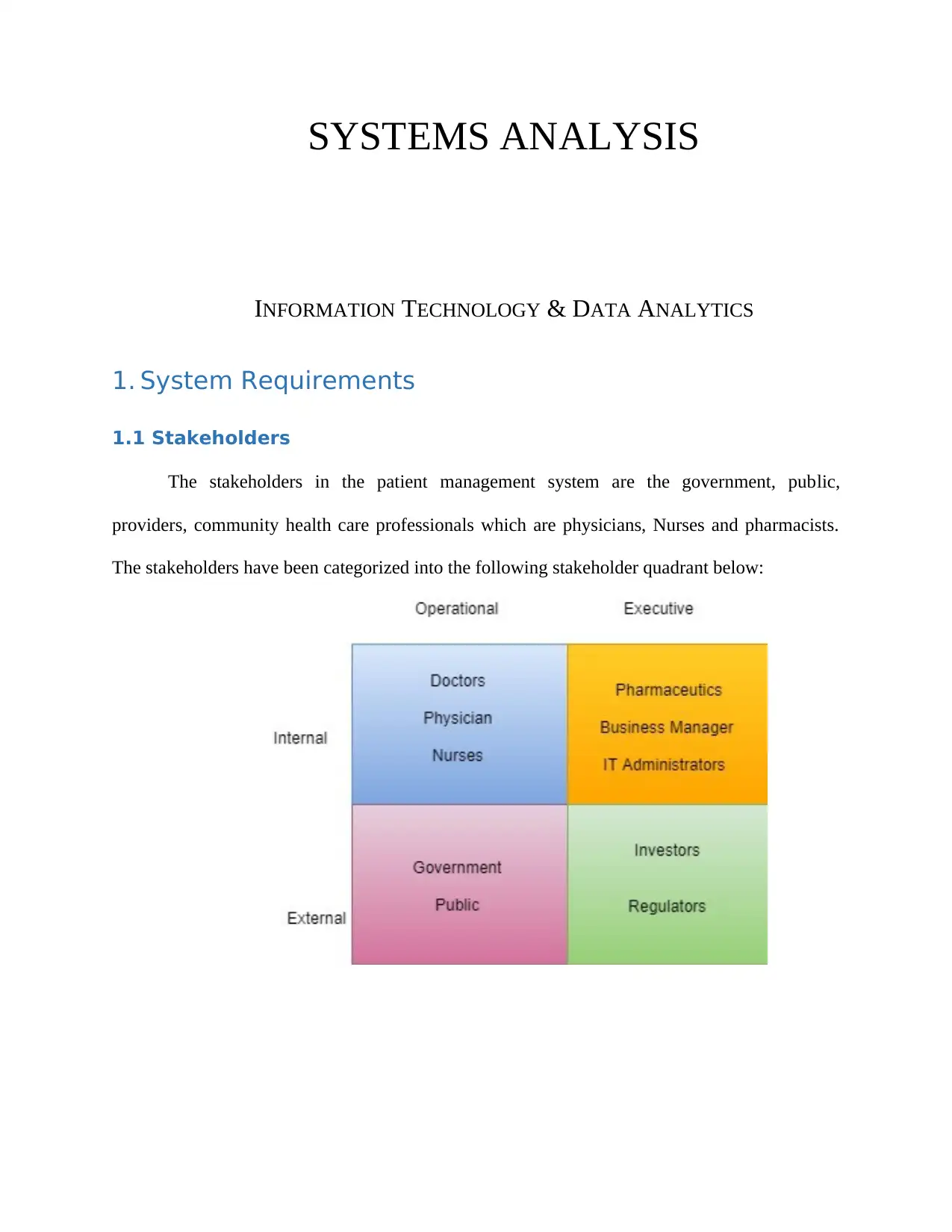
SYSTEMS ANALYSIS
INFORMATION TECHNOLOGY & DATA ANALYTICS
1. System Requirements
1.1 Stakeholders
The stakeholders in the patient management system are the government, public,
providers, community health care professionals which are physicians, Nurses and pharmacists.
The stakeholders have been categorized into the following stakeholder quadrant below:
INFORMATION TECHNOLOGY & DATA ANALYTICS
1. System Requirements
1.1 Stakeholders
The stakeholders in the patient management system are the government, public,
providers, community health care professionals which are physicians, Nurses and pharmacists.
The stakeholders have been categorized into the following stakeholder quadrant below:
Secure Best Marks with AI Grader
Need help grading? Try our AI Grader for instant feedback on your assignments.
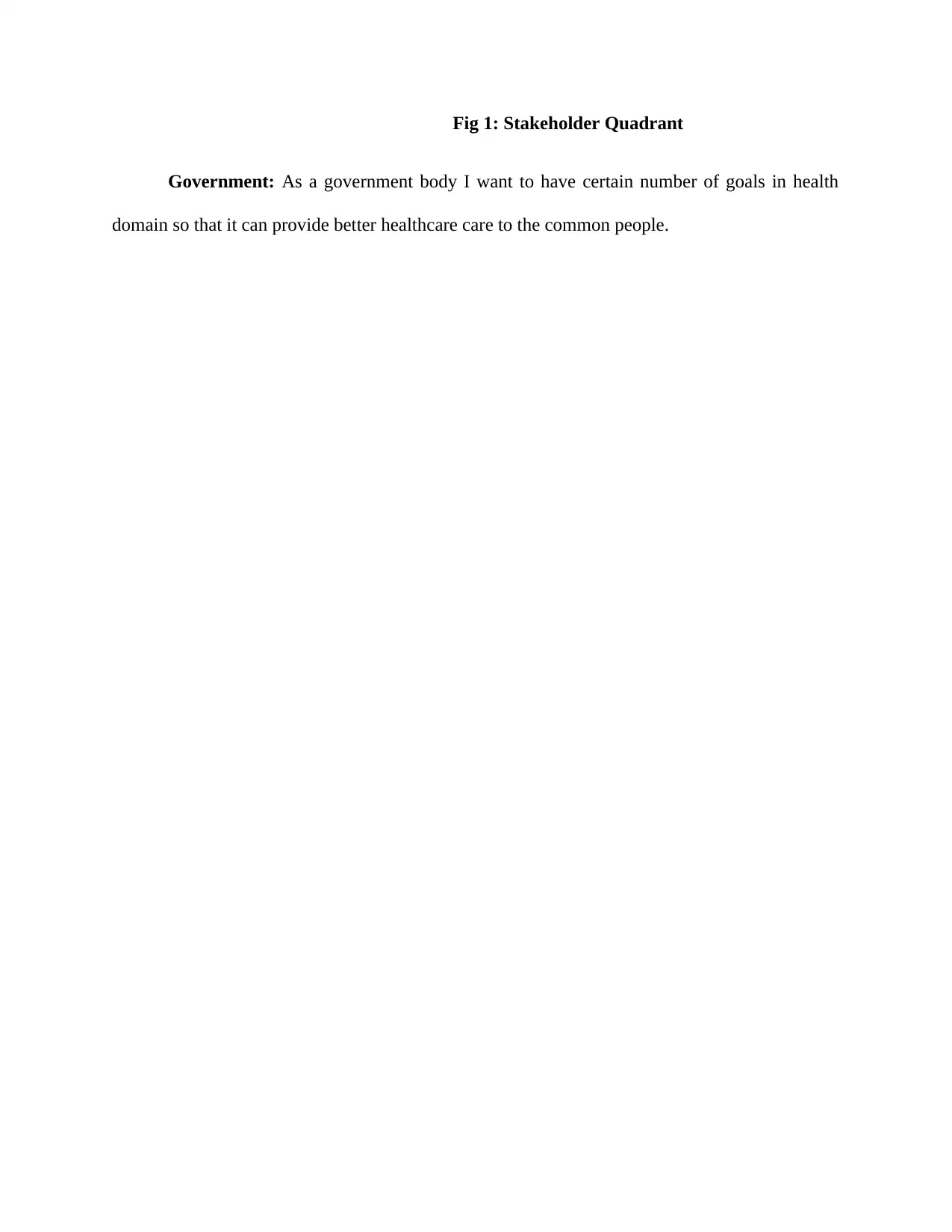
Fig 1: Stakeholder Quadrant
Government: As a government body I want to have certain number of goals in health
domain so that it can provide better healthcare care to the common people.
Government: As a government body I want to have certain number of goals in health
domain so that it can provide better healthcare care to the common people.
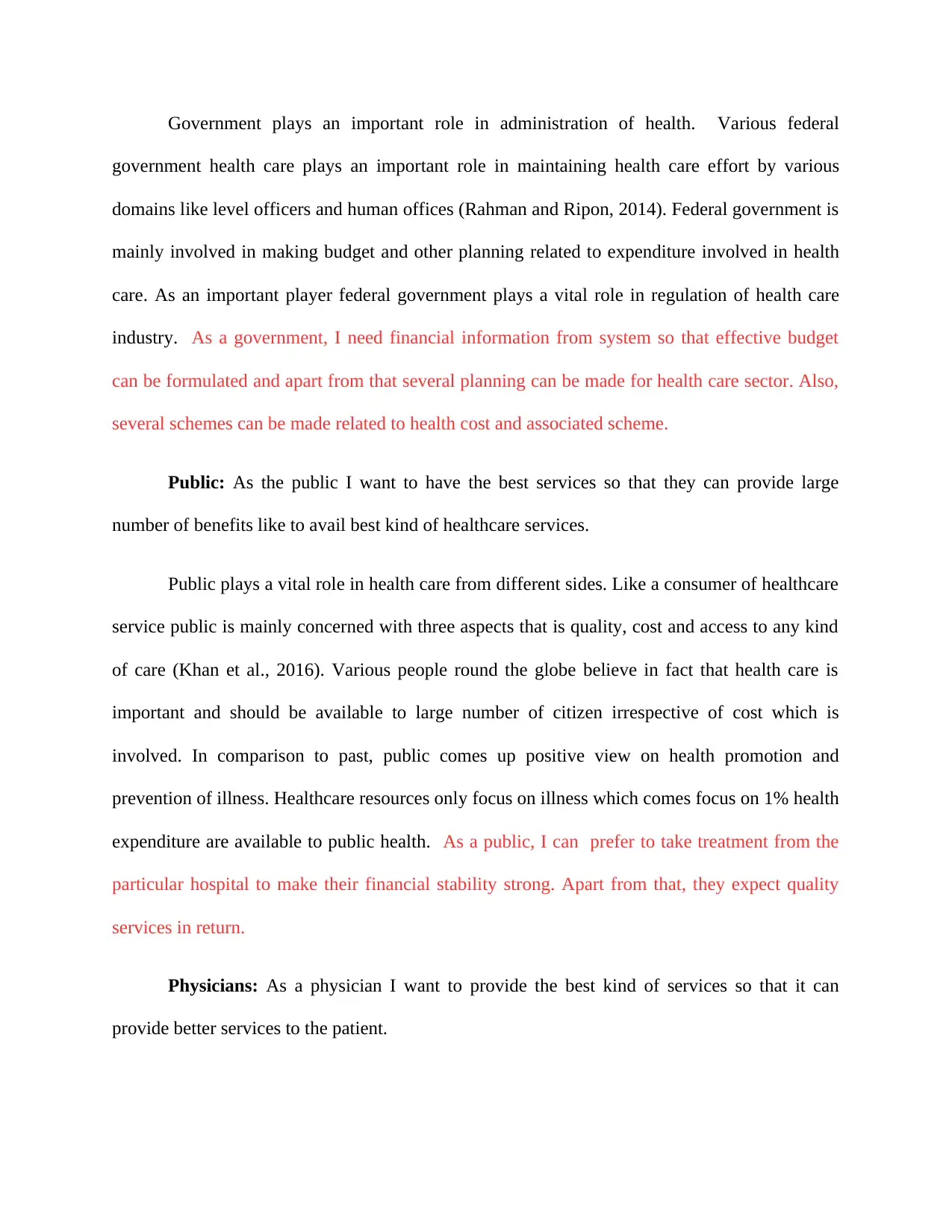
Government plays an important role in administration of health. Various federal
government health care plays an important role in maintaining health care effort by various
domains like level officers and human offices (Rahman and Ripon, 2014). Federal government is
mainly involved in making budget and other planning related to expenditure involved in health
care. As an important player federal government plays a vital role in regulation of health care
industry. As a government, I need financial information from system so that effective budget
can be formulated and apart from that several planning can be made for health care sector. Also,
several schemes can be made related to health cost and associated scheme.
Public: As the public I want to have the best services so that they can provide large
number of benefits like to avail best kind of healthcare services.
Public plays a vital role in health care from different sides. Like a consumer of healthcare
service public is mainly concerned with three aspects that is quality, cost and access to any kind
of care (Khan et al., 2016). Various people round the globe believe in fact that health care is
important and should be available to large number of citizen irrespective of cost which is
involved. In comparison to past, public comes up positive view on health promotion and
prevention of illness. Healthcare resources only focus on illness which comes focus on 1% health
expenditure are available to public health. As a public, I can prefer to take treatment from the
particular hospital to make their financial stability strong. Apart from that, they expect quality
services in return.
Physicians: As a physician I want to provide the best kind of services so that it can
provide better services to the patient.
government health care plays an important role in maintaining health care effort by various
domains like level officers and human offices (Rahman and Ripon, 2014). Federal government is
mainly involved in making budget and other planning related to expenditure involved in health
care. As an important player federal government plays a vital role in regulation of health care
industry. As a government, I need financial information from system so that effective budget
can be formulated and apart from that several planning can be made for health care sector. Also,
several schemes can be made related to health cost and associated scheme.
Public: As the public I want to have the best services so that they can provide large
number of benefits like to avail best kind of healthcare services.
Public plays a vital role in health care from different sides. Like a consumer of healthcare
service public is mainly concerned with three aspects that is quality, cost and access to any kind
of care (Khan et al., 2016). Various people round the globe believe in fact that health care is
important and should be available to large number of citizen irrespective of cost which is
involved. In comparison to past, public comes up positive view on health promotion and
prevention of illness. Healthcare resources only focus on illness which comes focus on 1% health
expenditure are available to public health. As a public, I can prefer to take treatment from the
particular hospital to make their financial stability strong. Apart from that, they expect quality
services in return.
Physicians: As a physician I want to provide the best kind of services so that it can
provide better services to the patient.
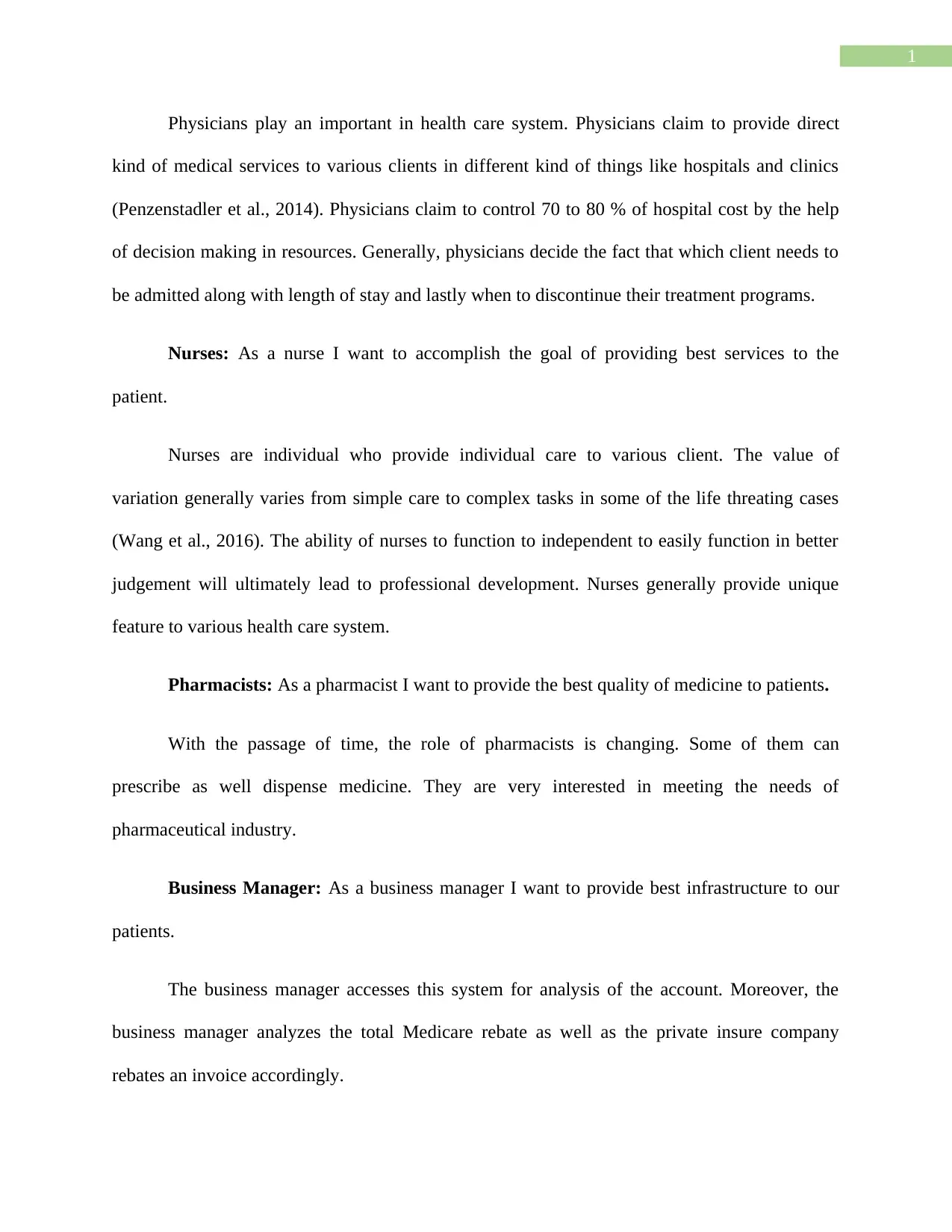
1
Physicians play an important in health care system. Physicians claim to provide direct
kind of medical services to various clients in different kind of things like hospitals and clinics
(Penzenstadler et al., 2014). Physicians claim to control 70 to 80 % of hospital cost by the help
of decision making in resources. Generally, physicians decide the fact that which client needs to
be admitted along with length of stay and lastly when to discontinue their treatment programs.
Nurses: As a nurse I want to accomplish the goal of providing best services to the
patient.
Nurses are individual who provide individual care to various client. The value of
variation generally varies from simple care to complex tasks in some of the life threating cases
(Wang et al., 2016). The ability of nurses to function to independent to easily function in better
judgement will ultimately lead to professional development. Nurses generally provide unique
feature to various health care system.
Pharmacists: As a pharmacist I want to provide the best quality of medicine to patients.
With the passage of time, the role of pharmacists is changing. Some of them can
prescribe as well dispense medicine. They are very interested in meeting the needs of
pharmaceutical industry.
Business Manager: As a business manager I want to provide best infrastructure to our
patients.
The business manager accesses this system for analysis of the account. Moreover, the
business manager analyzes the total Medicare rebate as well as the private insure company
rebates an invoice accordingly.
Physicians play an important in health care system. Physicians claim to provide direct
kind of medical services to various clients in different kind of things like hospitals and clinics
(Penzenstadler et al., 2014). Physicians claim to control 70 to 80 % of hospital cost by the help
of decision making in resources. Generally, physicians decide the fact that which client needs to
be admitted along with length of stay and lastly when to discontinue their treatment programs.
Nurses: As a nurse I want to accomplish the goal of providing best services to the
patient.
Nurses are individual who provide individual care to various client. The value of
variation generally varies from simple care to complex tasks in some of the life threating cases
(Wang et al., 2016). The ability of nurses to function to independent to easily function in better
judgement will ultimately lead to professional development. Nurses generally provide unique
feature to various health care system.
Pharmacists: As a pharmacist I want to provide the best quality of medicine to patients.
With the passage of time, the role of pharmacists is changing. Some of them can
prescribe as well dispense medicine. They are very interested in meeting the needs of
pharmaceutical industry.
Business Manager: As a business manager I want to provide best infrastructure to our
patients.
The business manager accesses this system for analysis of the account. Moreover, the
business manager analyzes the total Medicare rebate as well as the private insure company
rebates an invoice accordingly.
Secure Best Marks with AI Grader
Need help grading? Try our AI Grader for instant feedback on your assignments.
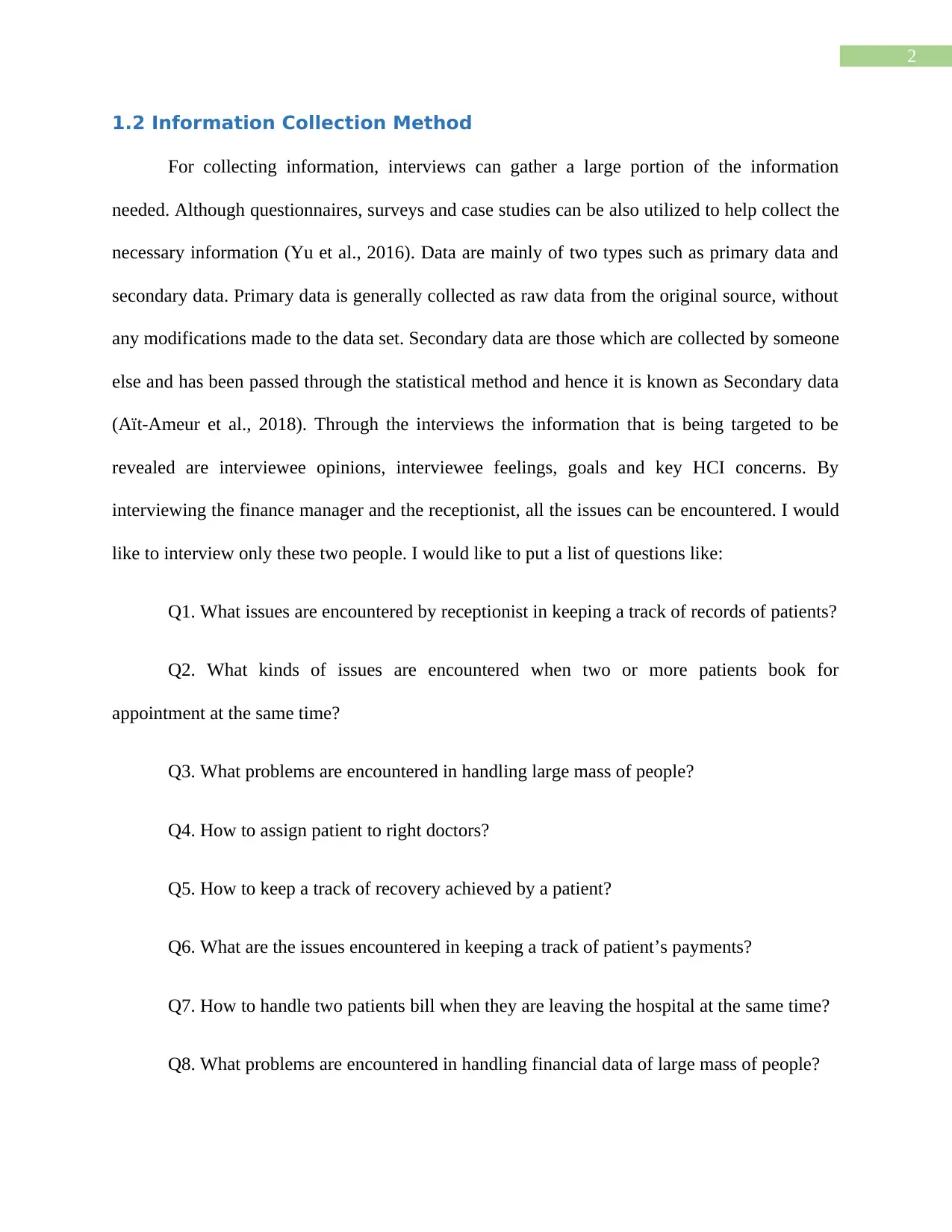
2
1.2 Information Collection Method
For collecting information, interviews can gather a large portion of the information
needed. Although questionnaires, surveys and case studies can be also utilized to help collect the
necessary information (Yu et al., 2016). Data are mainly of two types such as primary data and
secondary data. Primary data is generally collected as raw data from the original source, without
any modifications made to the data set. Secondary data are those which are collected by someone
else and has been passed through the statistical method and hence it is known as Secondary data
(Aït-Ameur et al., 2018). Through the interviews the information that is being targeted to be
revealed are interviewee opinions, interviewee feelings, goals and key HCI concerns. By
interviewing the finance manager and the receptionist, all the issues can be encountered. I would
like to interview only these two people. I would like to put a list of questions like:
Q1. What issues are encountered by receptionist in keeping a track of records of patients?
Q2. What kinds of issues are encountered when two or more patients book for
appointment at the same time?
Q3. What problems are encountered in handling large mass of people?
Q4. How to assign patient to right doctors?
Q5. How to keep a track of recovery achieved by a patient?
Q6. What are the issues encountered in keeping a track of patient’s payments?
Q7. How to handle two patients bill when they are leaving the hospital at the same time?
Q8. What problems are encountered in handling financial data of large mass of people?
1.2 Information Collection Method
For collecting information, interviews can gather a large portion of the information
needed. Although questionnaires, surveys and case studies can be also utilized to help collect the
necessary information (Yu et al., 2016). Data are mainly of two types such as primary data and
secondary data. Primary data is generally collected as raw data from the original source, without
any modifications made to the data set. Secondary data are those which are collected by someone
else and has been passed through the statistical method and hence it is known as Secondary data
(Aït-Ameur et al., 2018). Through the interviews the information that is being targeted to be
revealed are interviewee opinions, interviewee feelings, goals and key HCI concerns. By
interviewing the finance manager and the receptionist, all the issues can be encountered. I would
like to interview only these two people. I would like to put a list of questions like:
Q1. What issues are encountered by receptionist in keeping a track of records of patients?
Q2. What kinds of issues are encountered when two or more patients book for
appointment at the same time?
Q3. What problems are encountered in handling large mass of people?
Q4. How to assign patient to right doctors?
Q5. How to keep a track of recovery achieved by a patient?
Q6. What are the issues encountered in keeping a track of patient’s payments?
Q7. How to handle two patients bill when they are leaving the hospital at the same time?
Q8. What problems are encountered in handling financial data of large mass of people?
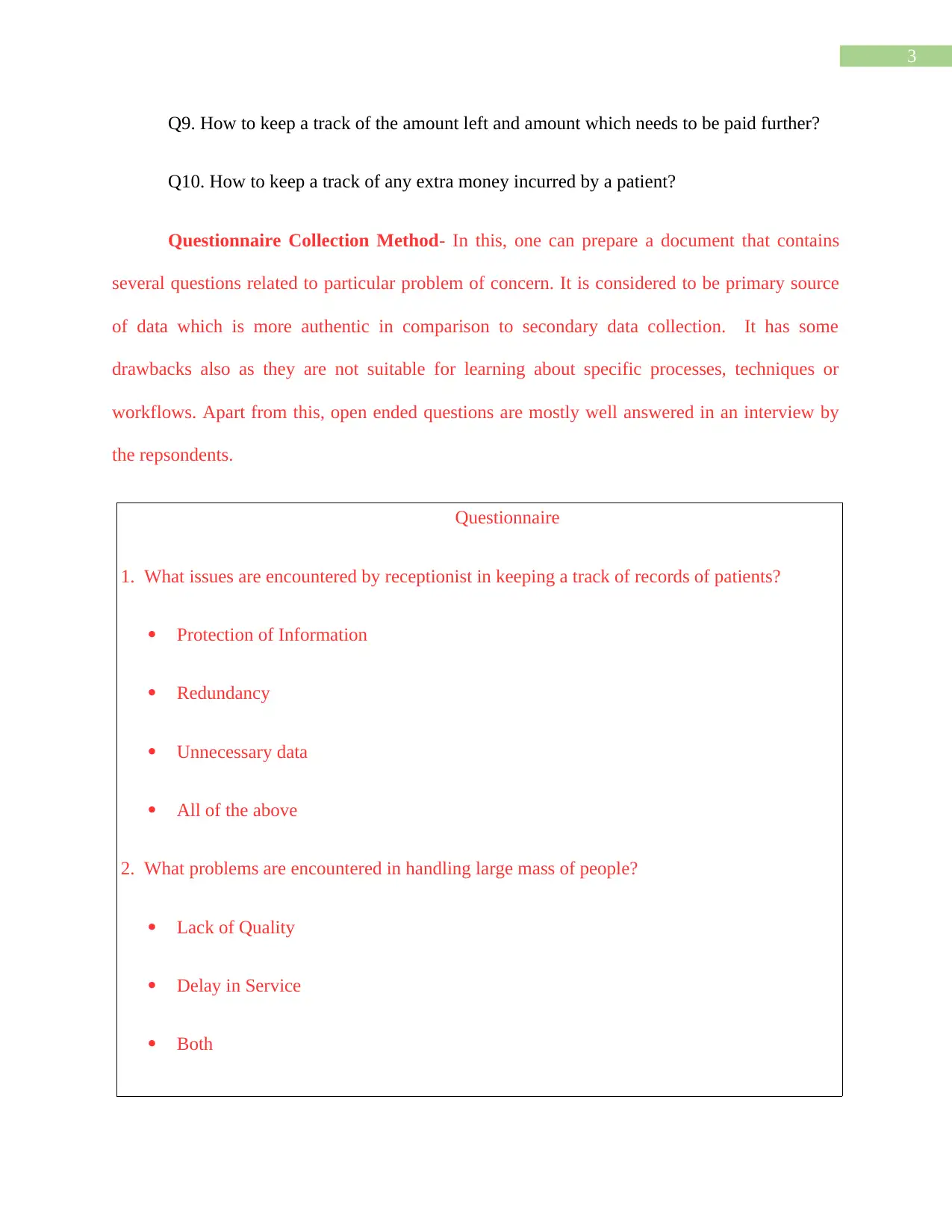
3
Q9. How to keep a track of the amount left and amount which needs to be paid further?
Q10. How to keep a track of any extra money incurred by a patient?
Questionnaire Collection Method- In this, one can prepare a document that contains
several questions related to particular problem of concern. It is considered to be primary source
of data which is more authentic in comparison to secondary data collection. It has some
drawbacks also as they are not suitable for learning about specific processes, techniques or
workflows. Apart from this, open ended questions are mostly well answered in an interview by
the repsondents.
Questionnaire
1. What issues are encountered by receptionist in keeping a track of records of patients?
Protection of Information
Redundancy
Unnecessary data
All of the above
2. What problems are encountered in handling large mass of people?
Lack of Quality
Delay in Service
Both
Q9. How to keep a track of the amount left and amount which needs to be paid further?
Q10. How to keep a track of any extra money incurred by a patient?
Questionnaire Collection Method- In this, one can prepare a document that contains
several questions related to particular problem of concern. It is considered to be primary source
of data which is more authentic in comparison to secondary data collection. It has some
drawbacks also as they are not suitable for learning about specific processes, techniques or
workflows. Apart from this, open ended questions are mostly well answered in an interview by
the repsondents.
Questionnaire
1. What issues are encountered by receptionist in keeping a track of records of patients?
Protection of Information
Redundancy
Unnecessary data
All of the above
2. What problems are encountered in handling large mass of people?
Lack of Quality
Delay in Service
Both
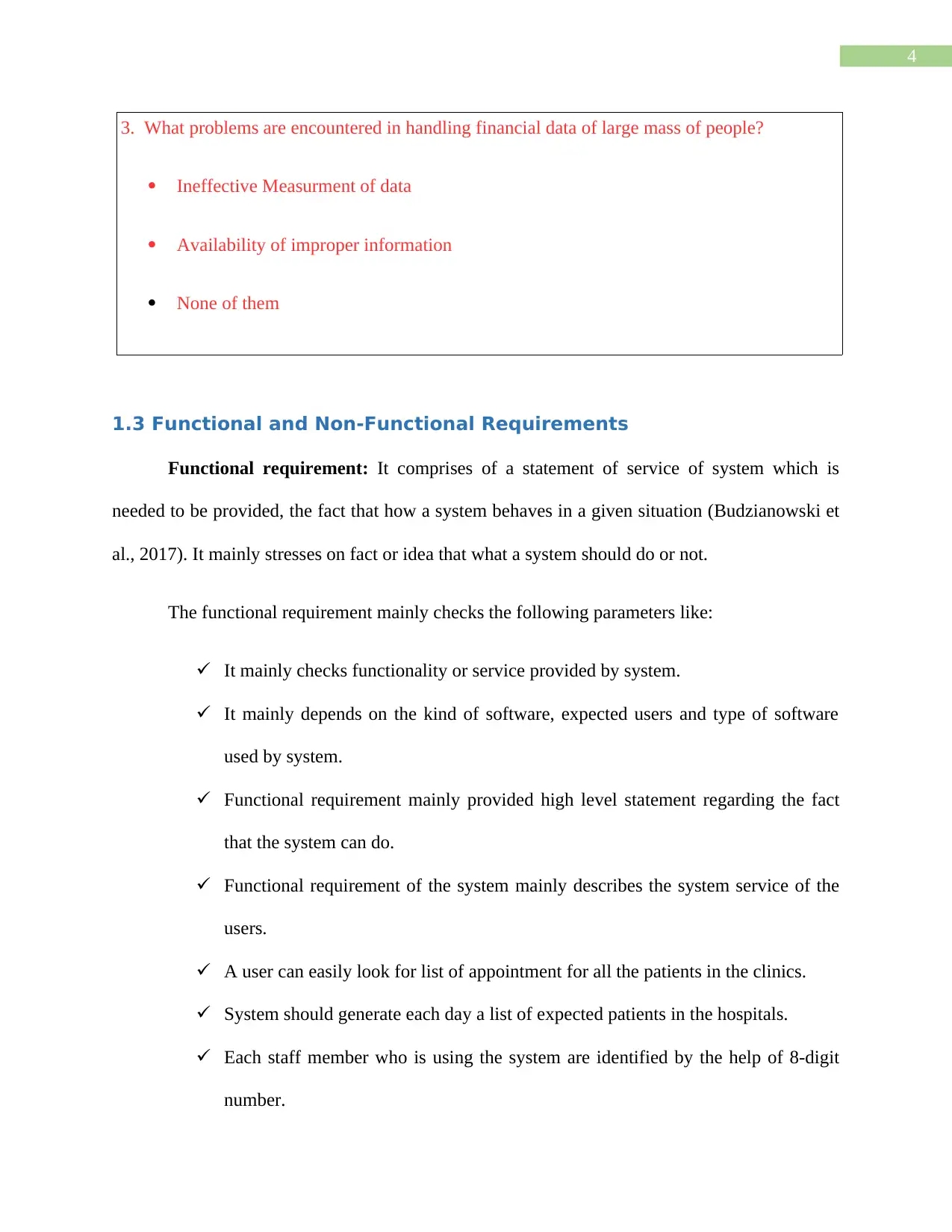
4
3. What problems are encountered in handling financial data of large mass of people?
Ineffective Measurment of data
Availability of improper information
None of them
1.3 Functional and Non-Functional Requirements
Functional requirement: It comprises of a statement of service of system which is
needed to be provided, the fact that how a system behaves in a given situation (Budzianowski et
al., 2017). It mainly stresses on fact or idea that what a system should do or not.
The functional requirement mainly checks the following parameters like:
It mainly checks functionality or service provided by system.
It mainly depends on the kind of software, expected users and type of software
used by system.
Functional requirement mainly provided high level statement regarding the fact
that the system can do.
Functional requirement of the system mainly describes the system service of the
users.
A user can easily look for list of appointment for all the patients in the clinics.
System should generate each day a list of expected patients in the hospitals.
Each staff member who is using the system are identified by the help of 8-digit
number.
3. What problems are encountered in handling financial data of large mass of people?
Ineffective Measurment of data
Availability of improper information
None of them
1.3 Functional and Non-Functional Requirements
Functional requirement: It comprises of a statement of service of system which is
needed to be provided, the fact that how a system behaves in a given situation (Budzianowski et
al., 2017). It mainly stresses on fact or idea that what a system should do or not.
The functional requirement mainly checks the following parameters like:
It mainly checks functionality or service provided by system.
It mainly depends on the kind of software, expected users and type of software
used by system.
Functional requirement mainly provided high level statement regarding the fact
that the system can do.
Functional requirement of the system mainly describes the system service of the
users.
A user can easily look for list of appointment for all the patients in the clinics.
System should generate each day a list of expected patients in the hospitals.
Each staff member who is using the system are identified by the help of 8-digit
number.
Paraphrase This Document
Need a fresh take? Get an instant paraphrase of this document with our AI Paraphraser
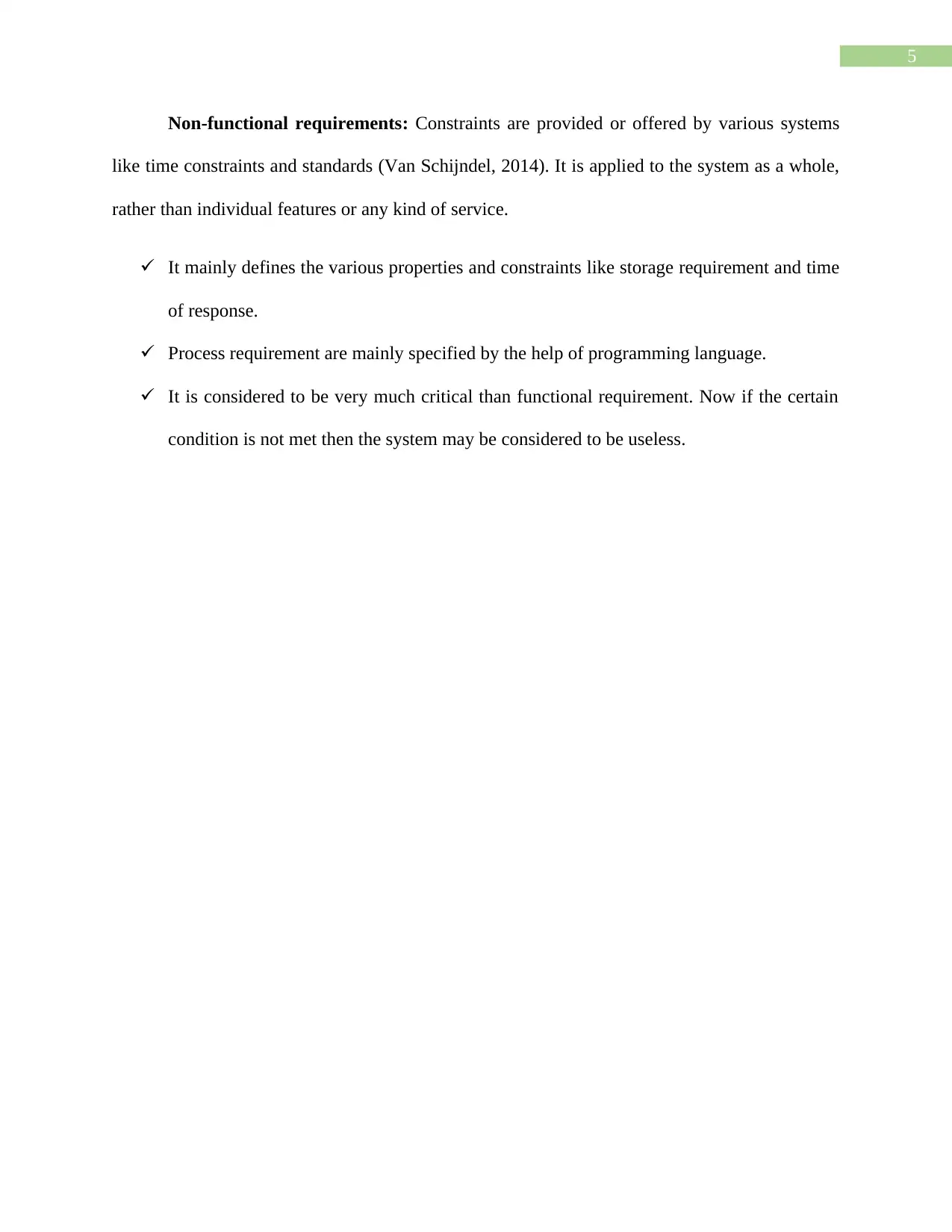
5
Non-functional requirements: Constraints are provided or offered by various systems
like time constraints and standards (Van Schijndel, 2014). It is applied to the system as a whole,
rather than individual features or any kind of service.
It mainly defines the various properties and constraints like storage requirement and time
of response.
Process requirement are mainly specified by the help of programming language.
It is considered to be very much critical than functional requirement. Now if the certain
condition is not met then the system may be considered to be useless.
Non-functional requirements: Constraints are provided or offered by various systems
like time constraints and standards (Van Schijndel, 2014). It is applied to the system as a whole,
rather than individual features or any kind of service.
It mainly defines the various properties and constraints like storage requirement and time
of response.
Process requirement are mainly specified by the help of programming language.
It is considered to be very much critical than functional requirement. Now if the certain
condition is not met then the system may be considered to be useless.
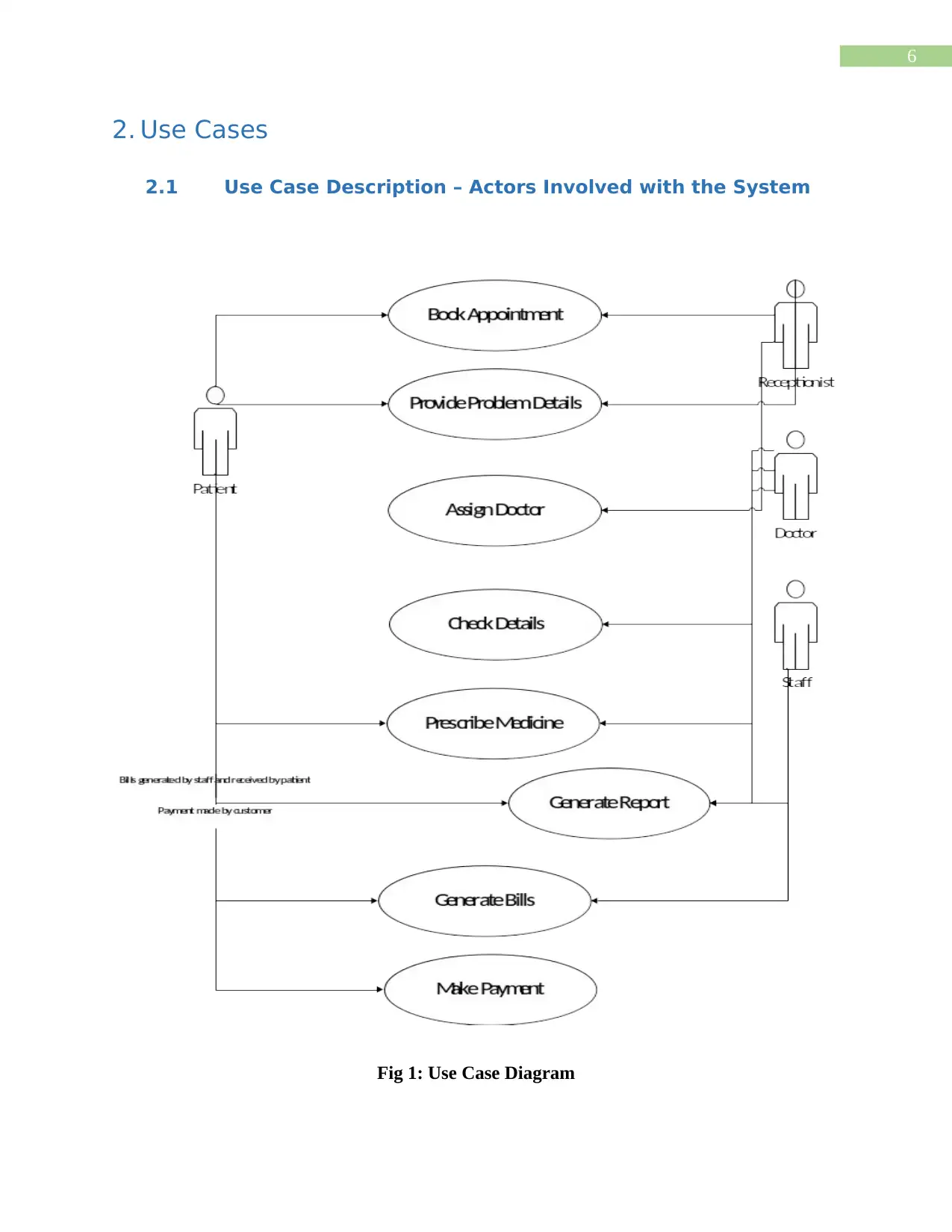
6
2. Use Cases
2.1 Use Case Description – Actors Involved with the System
Fig 1: Use Case Diagram
2. Use Cases
2.1 Use Case Description – Actors Involved with the System
Fig 1: Use Case Diagram
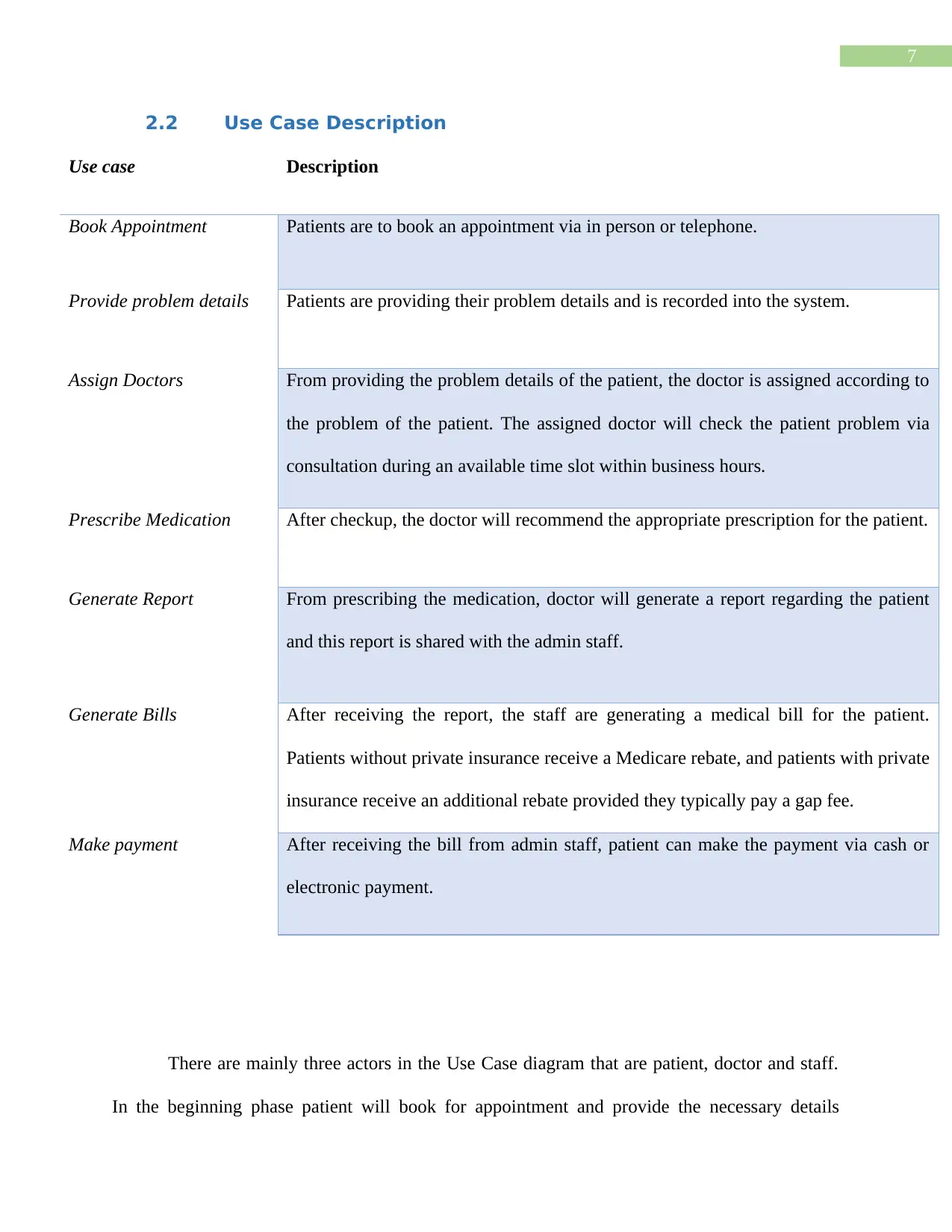
7
2.2 Use Case Description
Use case Description
Book Appointment Patients are to book an appointment via in person or telephone.
Provide problem details Patients are providing their problem details and is recorded into the system.
Assign Doctors From providing the problem details of the patient, the doctor is assigned according to
the problem of the patient. The assigned doctor will check the patient problem via
consultation during an available time slot within business hours.
Prescribe Medication After checkup, the doctor will recommend the appropriate prescription for the patient.
Generate Report From prescribing the medication, doctor will generate a report regarding the patient
and this report is shared with the admin staff.
Generate Bills After receiving the report, the staff are generating a medical bill for the patient.
Patients without private insurance receive a Medicare rebate, and patients with private
insurance receive an additional rebate provided they typically pay a gap fee.
Make payment After receiving the bill from admin staff, patient can make the payment via cash or
electronic payment.
There are mainly three actors in the Use Case diagram that are patient, doctor and staff.
In the beginning phase patient will book for appointment and provide the necessary details
2.2 Use Case Description
Use case Description
Book Appointment Patients are to book an appointment via in person or telephone.
Provide problem details Patients are providing their problem details and is recorded into the system.
Assign Doctors From providing the problem details of the patient, the doctor is assigned according to
the problem of the patient. The assigned doctor will check the patient problem via
consultation during an available time slot within business hours.
Prescribe Medication After checkup, the doctor will recommend the appropriate prescription for the patient.
Generate Report From prescribing the medication, doctor will generate a report regarding the patient
and this report is shared with the admin staff.
Generate Bills After receiving the report, the staff are generating a medical bill for the patient.
Patients without private insurance receive a Medicare rebate, and patients with private
insurance receive an additional rebate provided they typically pay a gap fee.
Make payment After receiving the bill from admin staff, patient can make the payment via cash or
electronic payment.
There are mainly three actors in the Use Case diagram that are patient, doctor and staff.
In the beginning phase patient will book for appointment and provide the necessary details
Secure Best Marks with AI Grader
Need help grading? Try our AI Grader for instant feedback on your assignments.
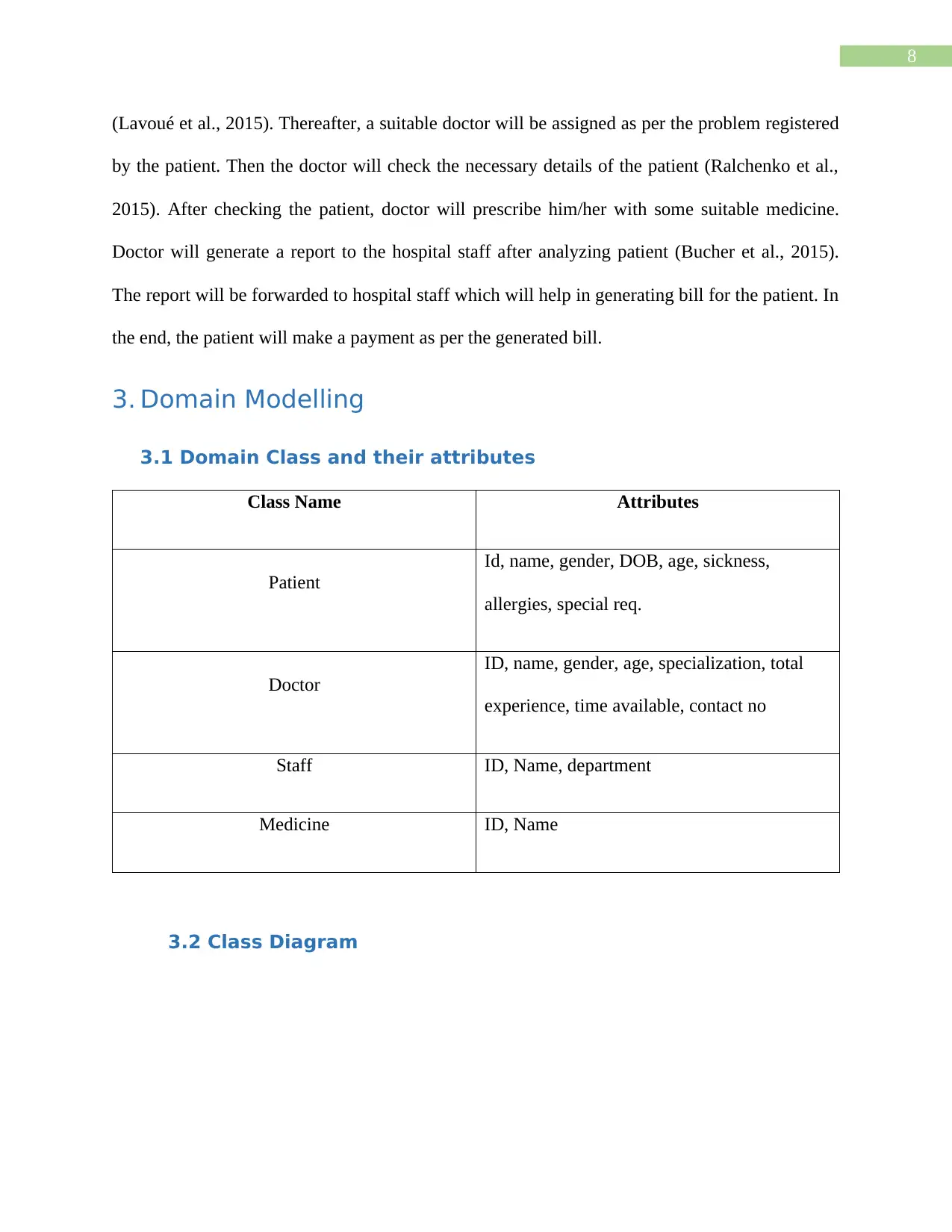
8
(Lavoué et al., 2015). Thereafter, a suitable doctor will be assigned as per the problem registered
by the patient. Then the doctor will check the necessary details of the patient (Ralchenko et al.,
2015). After checking the patient, doctor will prescribe him/her with some suitable medicine.
Doctor will generate a report to the hospital staff after analyzing patient (Bucher et al., 2015).
The report will be forwarded to hospital staff which will help in generating bill for the patient. In
the end, the patient will make a payment as per the generated bill.
3. Domain Modelling
3.1 Domain Class and their attributes
Class Name Attributes
Patient
Id, name, gender, DOB, age, sickness,
allergies, special req.
Doctor
ID, name, gender, age, specialization, total
experience, time available, contact no
Staff ID, Name, department
Medicine ID, Name
3.2 Class Diagram
(Lavoué et al., 2015). Thereafter, a suitable doctor will be assigned as per the problem registered
by the patient. Then the doctor will check the necessary details of the patient (Ralchenko et al.,
2015). After checking the patient, doctor will prescribe him/her with some suitable medicine.
Doctor will generate a report to the hospital staff after analyzing patient (Bucher et al., 2015).
The report will be forwarded to hospital staff which will help in generating bill for the patient. In
the end, the patient will make a payment as per the generated bill.
3. Domain Modelling
3.1 Domain Class and their attributes
Class Name Attributes
Patient
Id, name, gender, DOB, age, sickness,
allergies, special req.
Doctor
ID, name, gender, age, specialization, total
experience, time available, contact no
Staff ID, Name, department
Medicine ID, Name
3.2 Class Diagram
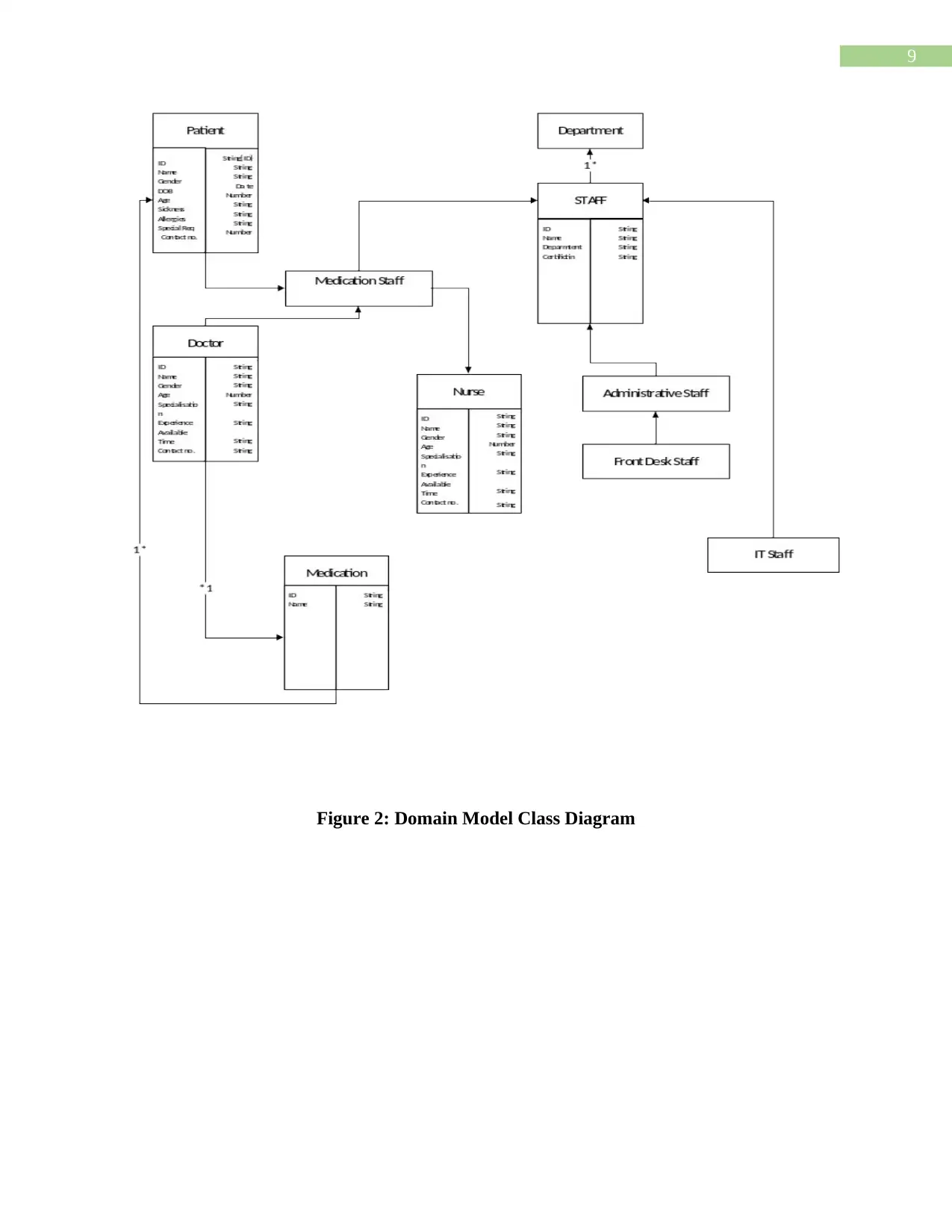
9
Figure 2: Domain Model Class Diagram
Figure 2: Domain Model Class Diagram
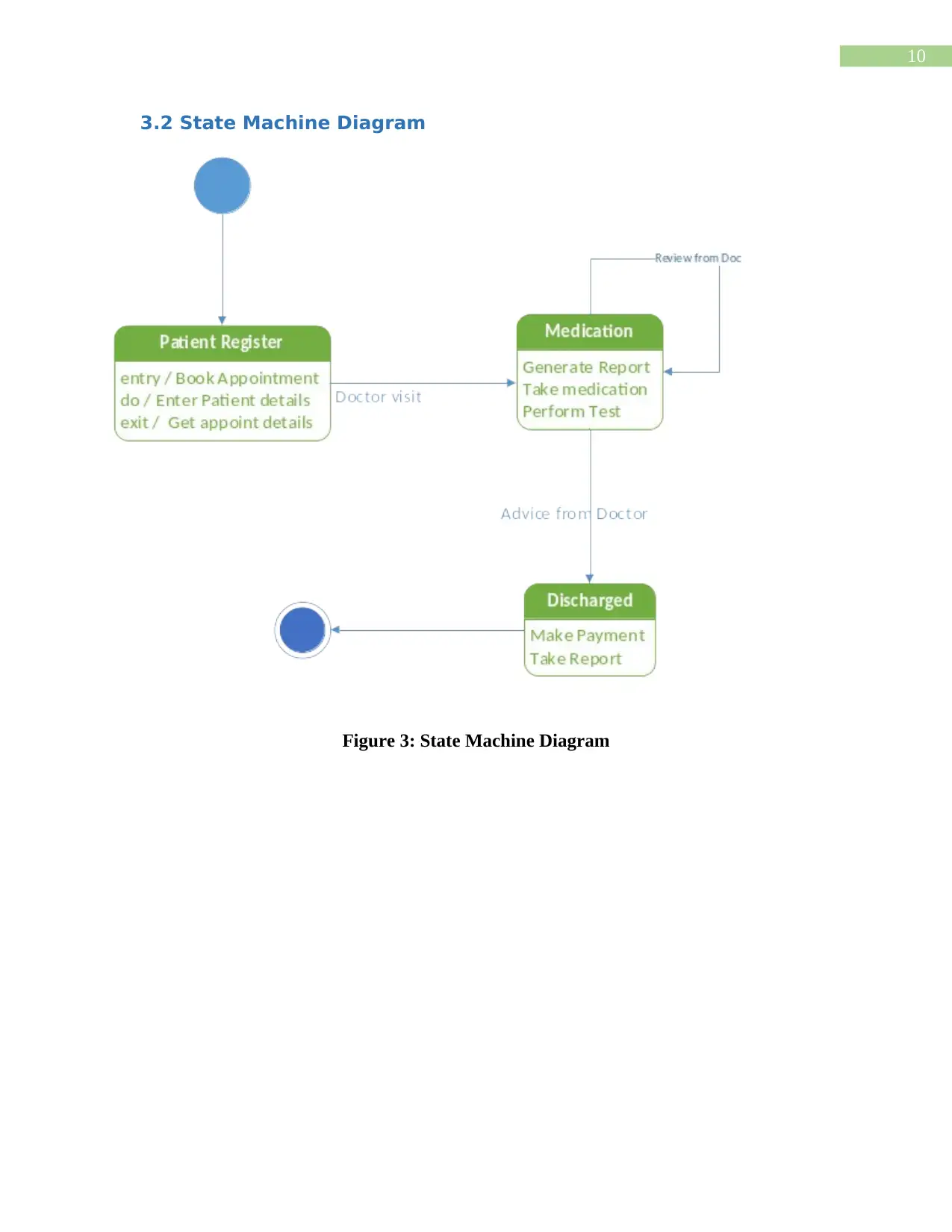
10
3.2 State Machine Diagram
Figure 3: State Machine Diagram
3.2 State Machine Diagram
Figure 3: State Machine Diagram
Paraphrase This Document
Need a fresh take? Get an instant paraphrase of this document with our AI Paraphraser
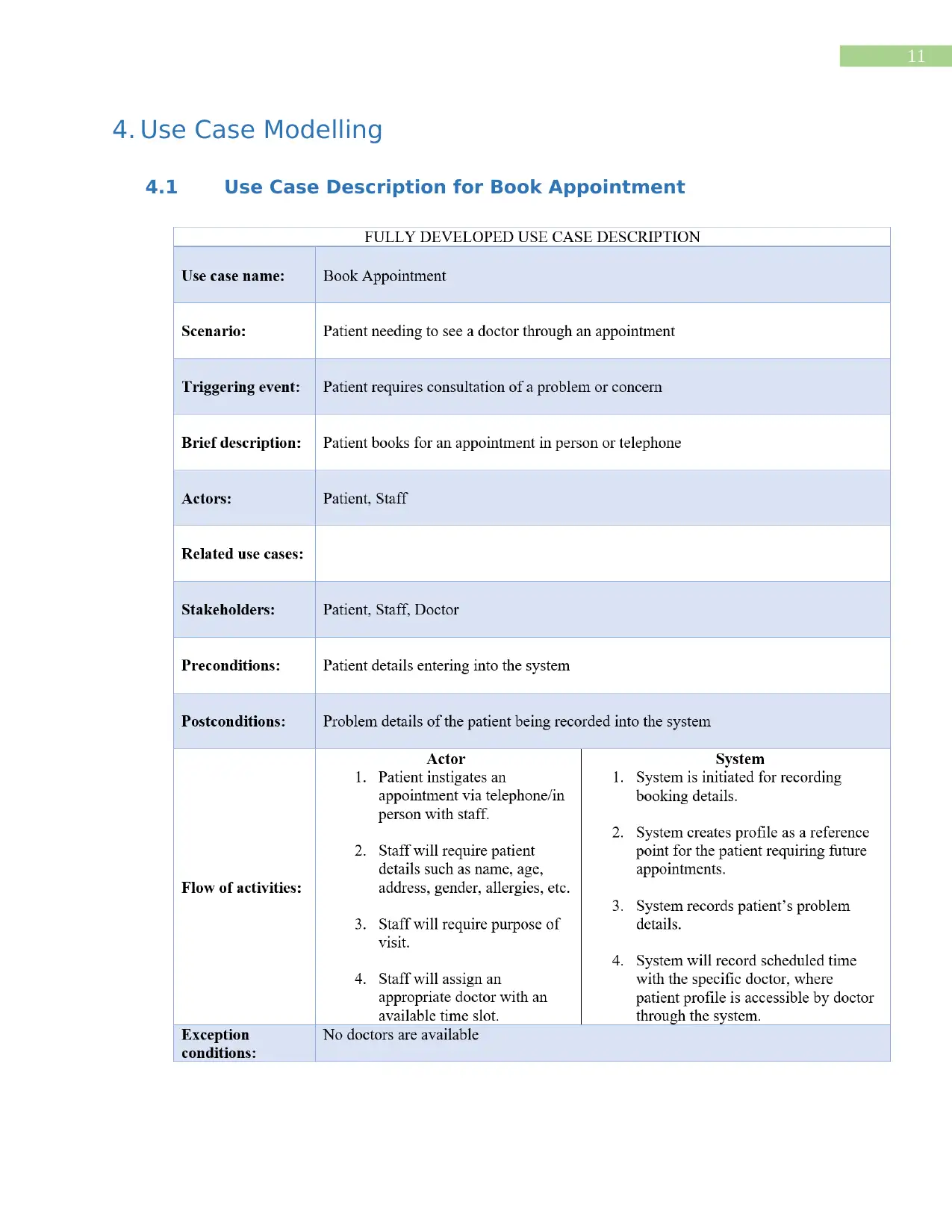
11
4. Use Case Modelling
4.1 Use Case Description for Book Appointment
4. Use Case Modelling
4.1 Use Case Description for Book Appointment
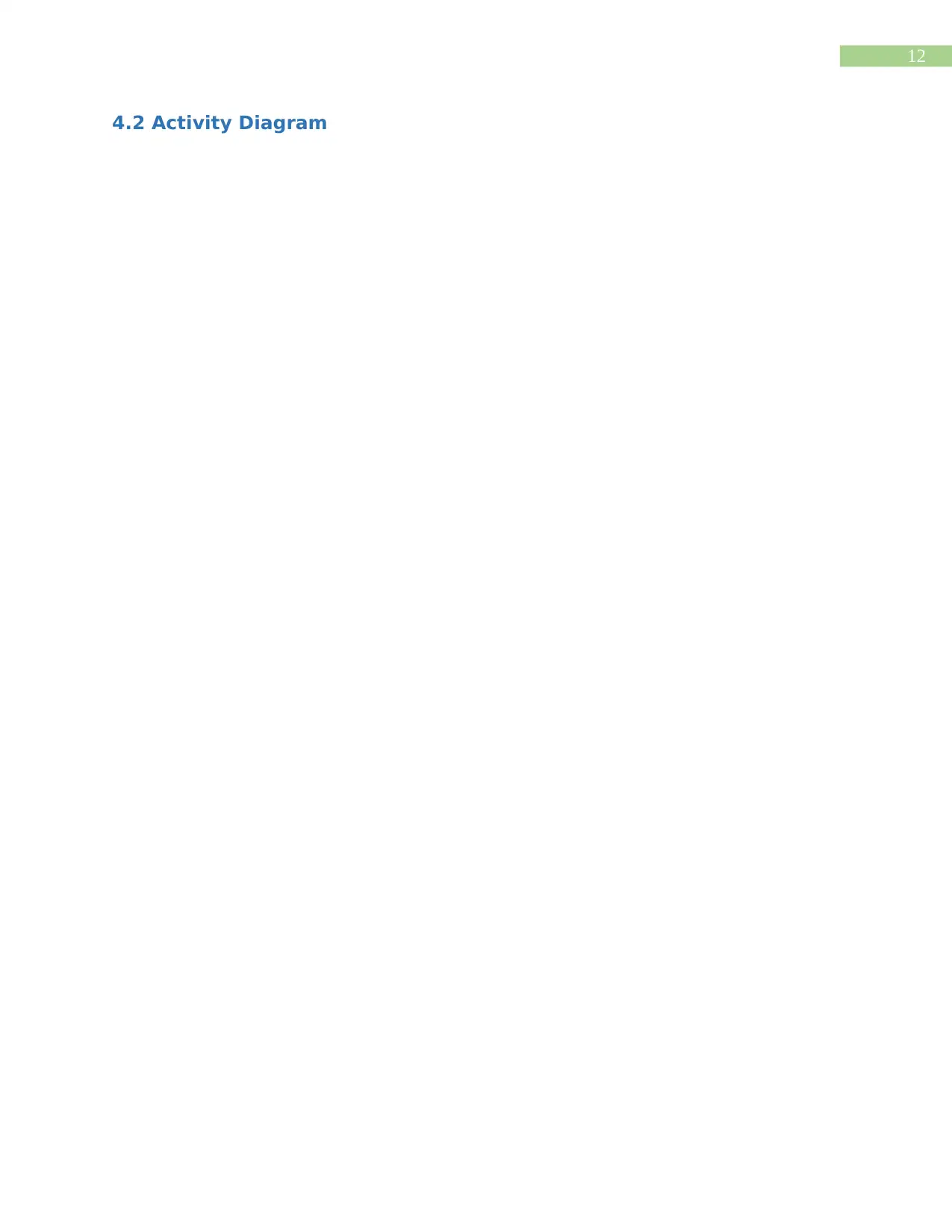
12
4.2 Activity Diagram
4.2 Activity Diagram
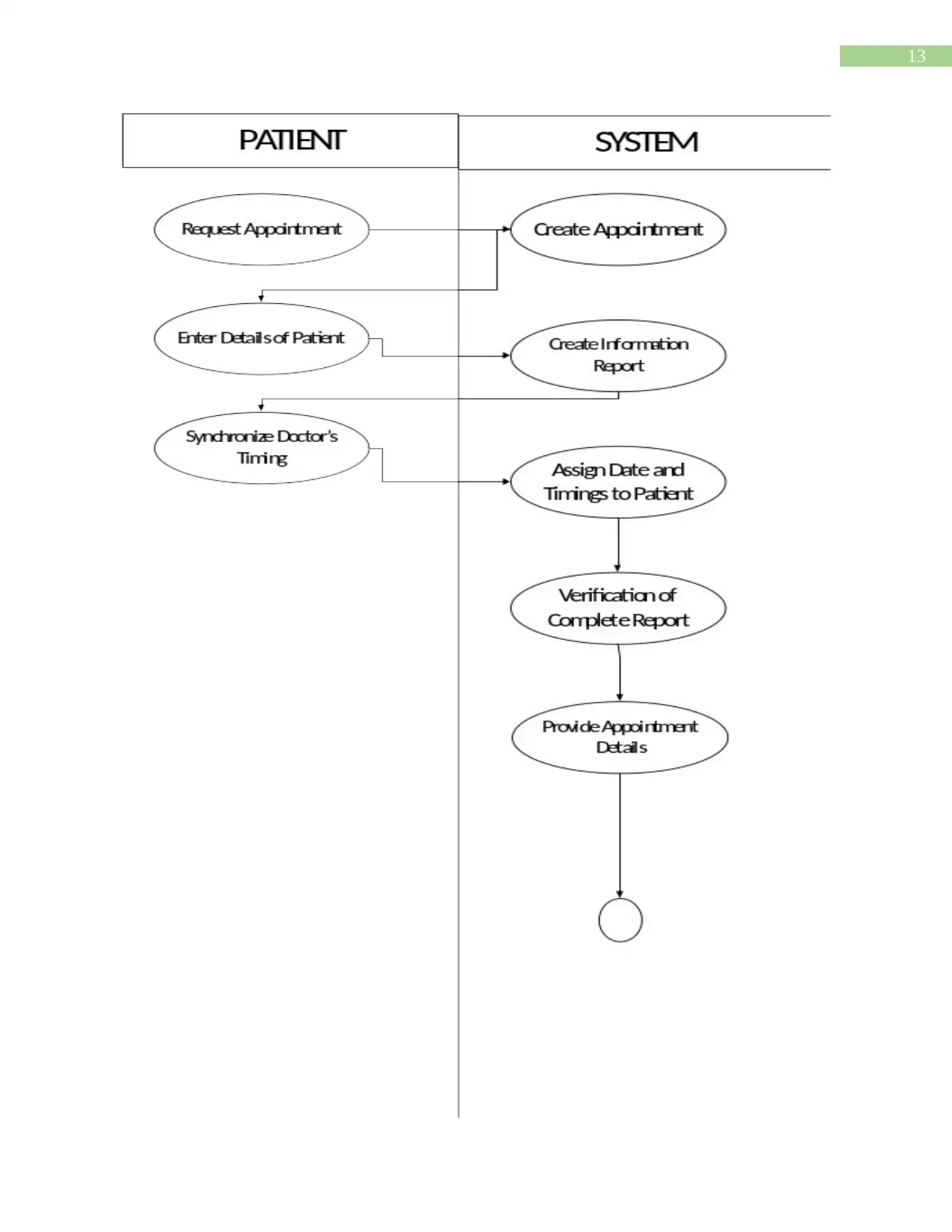
13
Secure Best Marks with AI Grader
Need help grading? Try our AI Grader for instant feedback on your assignments.

14
Figure 4: Activity Diagram
Figure 4: Activity Diagram
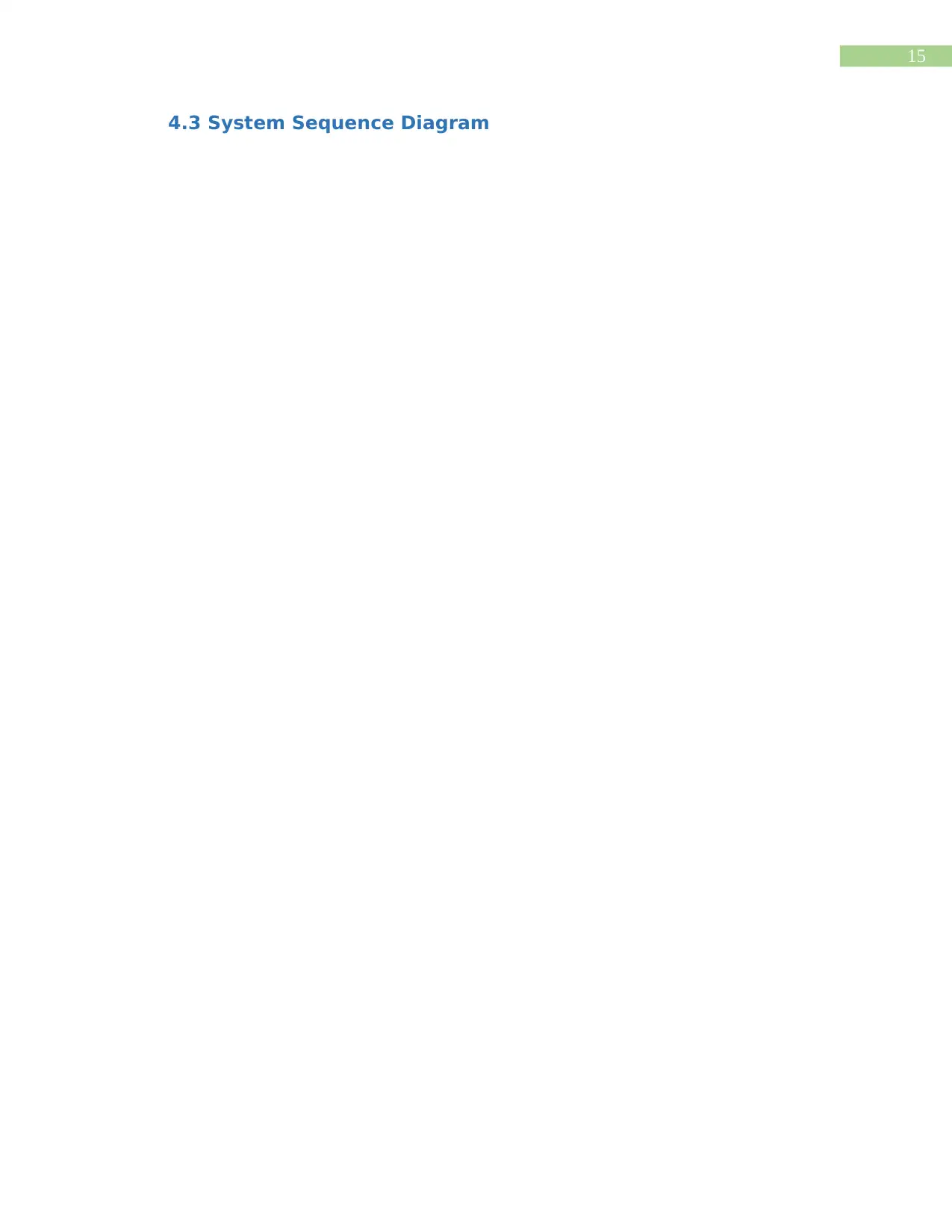
15
4.3 System Sequence Diagram
4.3 System Sequence Diagram
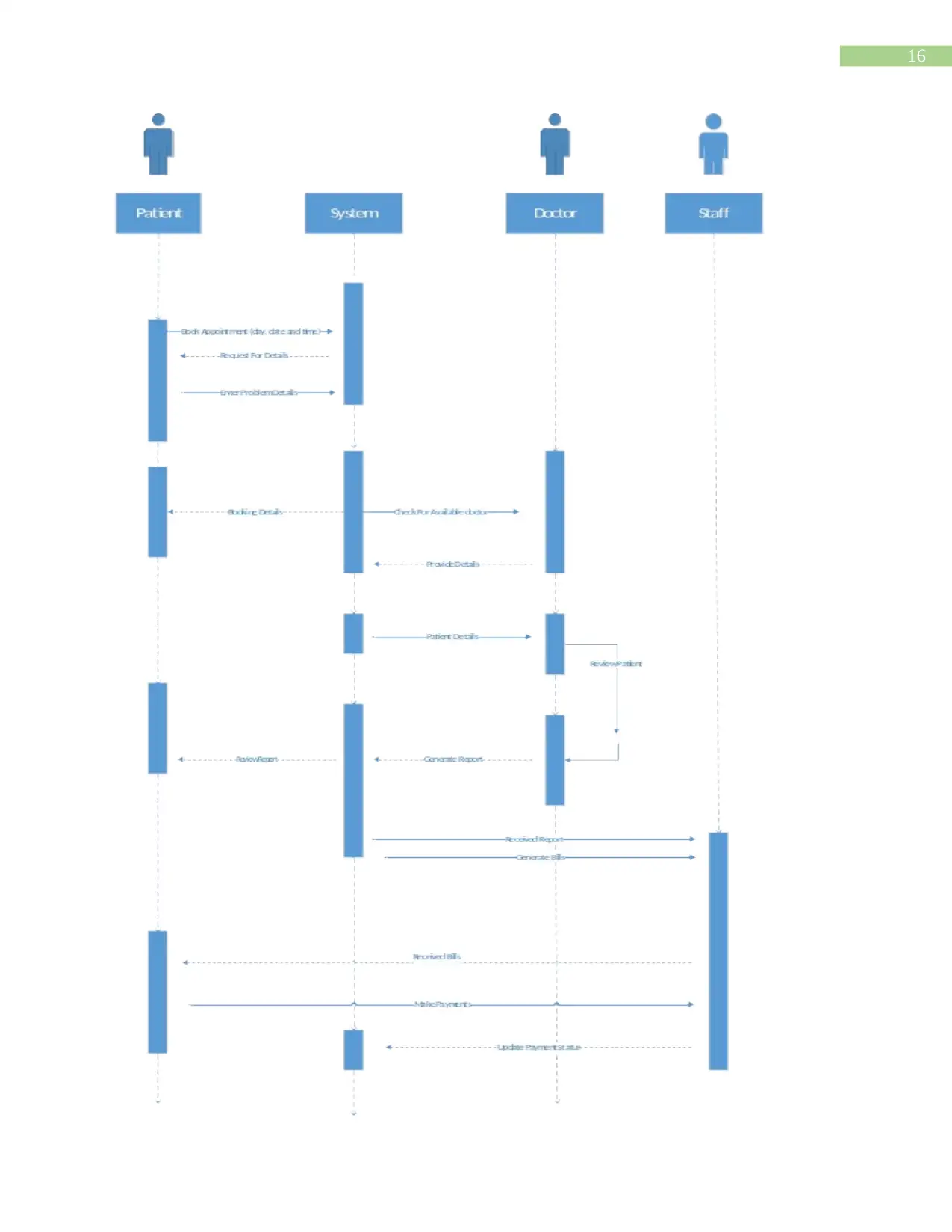
16
Paraphrase This Document
Need a fresh take? Get an instant paraphrase of this document with our AI Paraphraser
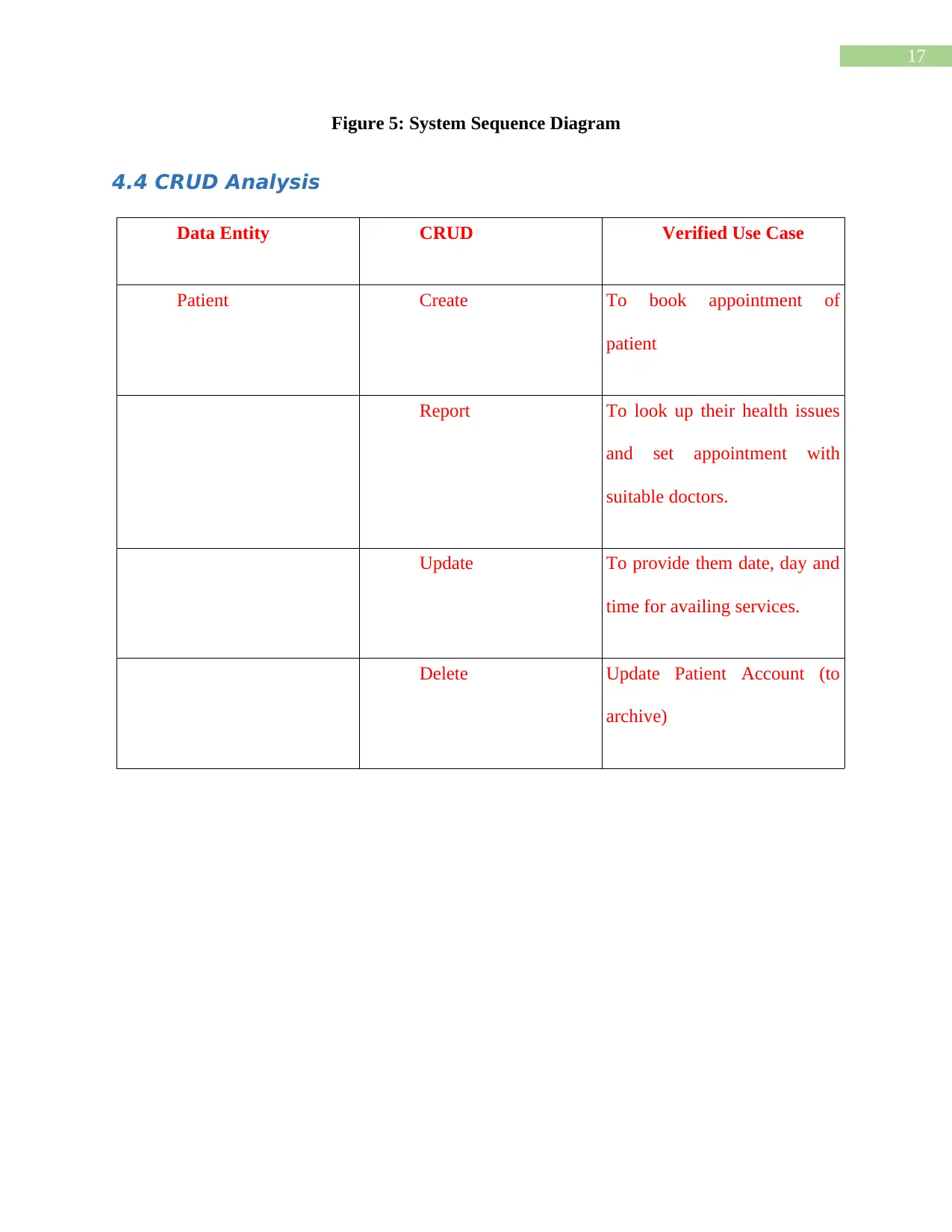
17
Figure 5: System Sequence Diagram
4.4 CRUD Analysis
Data Entity CRUD Verified Use Case
Patient Create To book appointment of
patient
Report To look up their health issues
and set appointment with
suitable doctors.
Update To provide them date, day and
time for availing services.
Delete Update Patient Account (to
archive)
Figure 5: System Sequence Diagram
4.4 CRUD Analysis
Data Entity CRUD Verified Use Case
Patient Create To book appointment of
patient
Report To look up their health issues
and set appointment with
suitable doctors.
Update To provide them date, day and
time for availing services.
Delete Update Patient Account (to
archive)
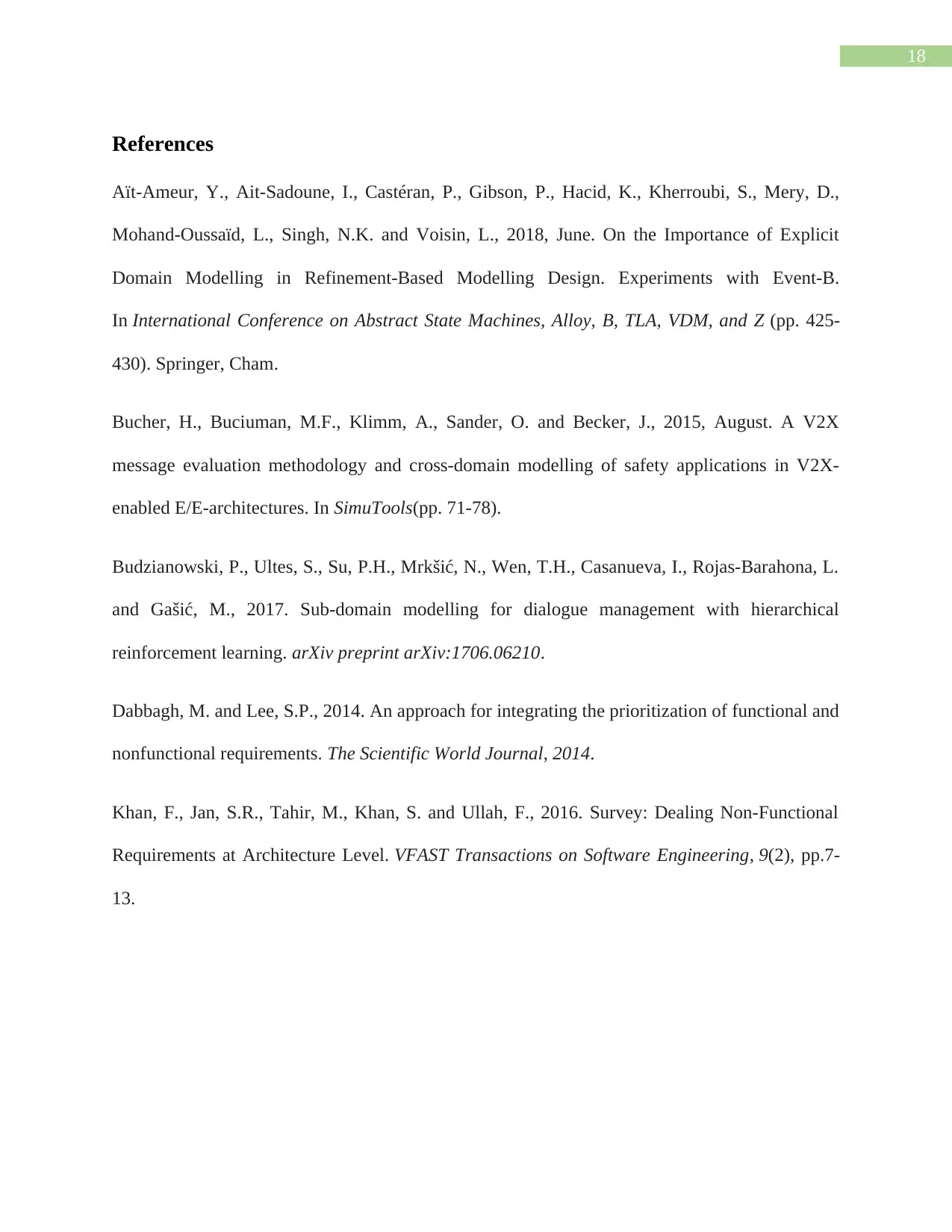
18
References
Aït-Ameur, Y., Ait-Sadoune, I., Castéran, P., Gibson, P., Hacid, K., Kherroubi, S., Mery, D.,
Mohand-Oussaïd, L., Singh, N.K. and Voisin, L., 2018, June. On the Importance of Explicit
Domain Modelling in Refinement-Based Modelling Design. Experiments with Event-B.
In International Conference on Abstract State Machines, Alloy, B, TLA, VDM, and Z (pp. 425-
430). Springer, Cham.
Bucher, H., Buciuman, M.F., Klimm, A., Sander, O. and Becker, J., 2015, August. A V2X
message evaluation methodology and cross-domain modelling of safety applications in V2X-
enabled E/E-architectures. In SimuTools(pp. 71-78).
Budzianowski, P., Ultes, S., Su, P.H., Mrkšić, N., Wen, T.H., Casanueva, I., Rojas-Barahona, L.
and Gašić, M., 2017. Sub-domain modelling for dialogue management with hierarchical
reinforcement learning. arXiv preprint arXiv:1706.06210.
Dabbagh, M. and Lee, S.P., 2014. An approach for integrating the prioritization of functional and
nonfunctional requirements. The Scientific World Journal, 2014.
Khan, F., Jan, S.R., Tahir, M., Khan, S. and Ullah, F., 2016. Survey: Dealing Non-Functional
Requirements at Architecture Level. VFAST Transactions on Software Engineering, 9(2), pp.7-
13.
References
Aït-Ameur, Y., Ait-Sadoune, I., Castéran, P., Gibson, P., Hacid, K., Kherroubi, S., Mery, D.,
Mohand-Oussaïd, L., Singh, N.K. and Voisin, L., 2018, June. On the Importance of Explicit
Domain Modelling in Refinement-Based Modelling Design. Experiments with Event-B.
In International Conference on Abstract State Machines, Alloy, B, TLA, VDM, and Z (pp. 425-
430). Springer, Cham.
Bucher, H., Buciuman, M.F., Klimm, A., Sander, O. and Becker, J., 2015, August. A V2X
message evaluation methodology and cross-domain modelling of safety applications in V2X-
enabled E/E-architectures. In SimuTools(pp. 71-78).
Budzianowski, P., Ultes, S., Su, P.H., Mrkšić, N., Wen, T.H., Casanueva, I., Rojas-Barahona, L.
and Gašić, M., 2017. Sub-domain modelling for dialogue management with hierarchical
reinforcement learning. arXiv preprint arXiv:1706.06210.
Dabbagh, M. and Lee, S.P., 2014. An approach for integrating the prioritization of functional and
nonfunctional requirements. The Scientific World Journal, 2014.
Khan, F., Jan, S.R., Tahir, M., Khan, S. and Ullah, F., 2016. Survey: Dealing Non-Functional
Requirements at Architecture Level. VFAST Transactions on Software Engineering, 9(2), pp.7-
13.
1 out of 21
Related Documents
Your All-in-One AI-Powered Toolkit for Academic Success.
+13062052269
info@desklib.com
Available 24*7 on WhatsApp / Email
![[object Object]](/_next/static/media/star-bottom.7253800d.svg)
Unlock your academic potential
© 2024 | Zucol Services PVT LTD | All rights reserved.





